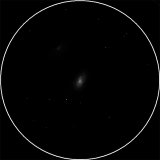
| MESSIER 87 |
|---|
RA: |
12h 30m 48s |
|
DEC: |
+12° 24' 00'' |
|
Type: |
Elliptical galaxy |
|
NGC: |
4486 |
|
Magnitude: |
8.60 |
|
Surface brightness : |
13.00 |
|
Apparent dimensions : |
8.7'x6.6' |
|
Distance: |
60,000,000 ly |
|
M87 has been discovered and cataloged by Charles Messier on March 18, 1781 when he also cataloged 7 more nebulous objects in the same region, and actually are all member galaxies of the Virgo Cluster, as well as globular cluster M92. The giant elliptical galaxy M87, also called Virgo A, is one of the most remarkable objects in the sky. It is perhaps the dominant galaxy in the closest big cluster to us, the famous Virgo Cluster of galaxies (sometimes also called "Coma-Virgo cluster" which is more acurate, as it extends into constellation Coma), and lies at the distance of this cluster (about 60 million light-years). M87 lies well in the heart of the Virgo cluster (together with a lot of galaxies including M84 and M86). This giant is situated between a number of apparently close neighbors, some of them are probably physical satellites, while others may be apparent neighbors because of projection effects only. The brightest of these dwarf galaxies are: NGC 4476, NGC 4478, NGC 4486A, and NGC 4486B. This magnificient galaxy is perhaps the one with most known globular clusters. While our Milky Way has the modest number of roughly 150 to 200 globulars, M87 possesses a remarkable system of several thousands of these objects: Moderate estimates such as the 1976 work quoted by Burnham give numbers of at least 4,000, while more modern values go up to 15,000. The only supernova recorded for M87 appeared in February 1919, but was not detected before 1922 on photographic plates, by I. Balanowski, who estimated its maximum brightness as 11.5. At M87's distance, this corresponds to an absolute magnitude of nearly -20 mag. Visually, the M87 is very bright and easy to observe. Galaxy doesn't show any interesting details. It is just a elliptical ball of light with bright core. It looks very similar to the M32. |
||
VEDRAN VRHOVAC© 2006.-2007. |
